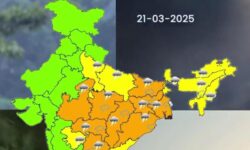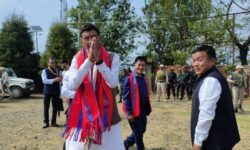
Rajib Barman, 39, had heard that the job of a rat-hole miner was hazardous, but he chose to do it because he had a debt of ₹60,000 to pay off. A resident of Sitlabazar village in western Assam’s Kokrajhar district, Barman decided to work at the Kalamati mine in the Umrangso area of Dima Hasao district via a middleman. He hoped to bring home ₹90,000 by working in the mine for two months at about ₹1,500 per day — more than thrice the usual wage in the rural parts of Assam. This translated into earning ₹90-100 per kilogramme of coal extracted at an average of 15 cartloads of the fossil fuel stripped off the mine.
On January 6, 2025, Barman descended into the dark pit for the first day of mining. “The sardar (supervisor of miners) had told us the previous night that we could start working as the water that had accumulated in the mine had been drained out,” Barman says. “We went down 250 feet below the ground at 4:30 a.m. and began working inside one of the tunnels.”
Barman’s body ached as he was working in an awkward position for the first time. After more than two hours, he decided to take a break and crawled back towards the mouth of the tunnel. Rat-holes are the labyrinthine passages that branch out from 300-foot-deep pits.
A few feet from the opening, Barman heard screams and the sound of gushing water growing louder. “Seconds later, I was swept into the pit,” he recalls. “I managed to clamber up the chain of the crane (used to haul coal) and get out. But my three room-mates could not make it.”
So far, of the nine miners trapped inside, only four bodies have been recovered. Search and rescue operations by the Indian Army, Navy, the National Disaster Response Force, and the State Disaster Response Force were on for the others, but five days ago, Navy divers were withdrawn from the operations. While dewatering of the mine continues, the government has assessed it could take up to 60 days to drain out all the water.
On January 16, 2025, the Assam Cabinet approved a judicial inquiry into the tragedy and decided to constitute a Special Investigation Team to probe the incident, one of the deadliest in recent times. It also decided to frame a standard operating procedure (SOP) to enforce a blanket ban on rat-hole mining in Assam apart from sealing some 220 pits surveyed so far.
Dangers lurk below
For Raju Basumatary, 55, this is the second time a disaster like this has taken place. The first time this happened was at Ksan in Meghalaya’s coal-rich East Jaintia Hills district on December 13, 2018. Then too, he was about 200 metres from the pit that devoured some of his fellow miners.
These, though, are not the only mishaps that Basumatary has encountered in 26 years as a rat-hole miner. He came to Kalamati from the Khliehriat area of Meghalaya four years ago.
“Khibakhibi hoiye thaakhe (Something or the other keeps happening),” he says, rattling off all the possibilities. “A miner slips to death in the pit, another is asphyxiated, somebody else dies after smelling toxic gas, the fourth drowns…”
Basumatary says miners put themselves at risk in the dark depths of the earth. All they have is a torch strapped to their head to guide them. “Still, the money is good and it is guaranteed as long as you extract coal during the season,” he says.
The “season” he refers to is the mining period between November and March. During the first two months of this period, workers invariably drain the water that fills the mines, which are often interlinked beneath the ground, because of rainfall and seepage from April to October.
Then they crawl into the mines and using pickaxes, extract coal from the walls of a rectangular tunnel that is 2-3 metres high or shovel about 20 kg of coal lumps onto a cart. They drag this to the mouth of the tunnel. Large metal troughs, operated with pulleys from a crane, haul a tonne or two of the coal to the surface.
Joseph Soren, 40, was in charge of loading the coal onto one of the troughs eased down from a crane when disaster struck on January 6. He was the last of the 23 miners who made it after helping those who could not swim escape first.
“I heard shouts of ‘water, water!’ and rumbling sounds. Before I could figure anything out, water carrying the miners shot out of the tunnels. We grabbed anything — the chains from the crane, the pipe of a water pump, ropes thrown down from people above — to save ourselves. The murky, stinging water made our eyes burn as we moved up. I struggled to keep my head above the water level,” he says.
Soren, who is from western Assam’s Chirang district, has worked in half a dozen mines in the Umrangso area, of which Kalamati is a part, over as many seasons, but he now has second thoughts about continuing mining. But then, the payment per season is good enough for his family of five to last at least a year.
The money was good enough for Ganga Bahadur Shresth, 38, of Nepal’s Rampur village, to travel three days from his home to a mine each season, says his wife, Sushila Rai. His was the first of the four bodies retrieved by rescue workers from the Kalamati mine. “His income from mining made our lives quite comfortable but he never let us know how dangerous his work was. We found this out too late,” says Rai, a mother of three.
Shresth came with more than 20 workers from Nepal to work in Umrangso. Among them was Lijan Magar, 27, who also lost his life. His was the second body to be retrieved. “We started living here after our wedding two years ago. I don’t know where to go with our two-month-old baby,” says Junu Pradhan, Magar’s wife.
The other two bodies retrieved were of Khushi Mohan Roy, 57, from Kokrajhar district’s Fakiragram, who was one of Barman’s room-mates; and of Sarat Goyari, 37, who hailed from Thailapara in north-central Assam’s Sonitpur district.
‘A huge scam’
For Assam’s landless or marginal farmers such as Mohammed Saifuddin Ahmed of Dalgaon in Darrang district, all roads lead to the mines when family expenditure exceeds income. The last time the 55-year-old worked in a coal mine was in March 2012, three months before 15 miners died in a flooded mine at Nongalbibra in Meghalaya’s South Garo Hills district. The mishap, and a petition filed by the All Dimasa Students’ Union of Assam, led to the National Green Tribunal (NGT) banning rat-hole coal mining in Meghalaya on April 17, 2014. Upheld by the Supreme Court later, the ban was extended to the other States in the Northeast. “But circumstances made me return to mining after all these years because, ban or not, no other job pays as much,” Ahmed says.
The Ksan incident in 2018 and Kalamati now make it evident that the ban has largely been on paper. In Meghalaya, the Justice (retired) B.P. Katakey-headed committee, which was appointed by the High Court of Meghalaya in April 2022 to investigate ongoing illegal coal mining and transportation, continues to receive complaints. One of the new complaints the panel has received relates to illegal mining in Nongalbibra, where the process of banning rat-hole mines began.
“The illegal tag has only increased the price of coal; it has not stopped mining,” says Shillong-based anti-mining activist Agnes Kharshiing, who survived a violent attack by coal mine owners in 2018. “Hundreds of trucks continue to transport coal on the highways feeding the coke units and cement plants. You can see mounds of freshly extracted coal on the roadside. The police, politicians, bureaucrats, landowners… almost all of them are involved.” In 2023, the High Court of Meghalaya made a similar observation, saying the complicity of the State with the mafia operating illegal coal mines was “clear and obvious”.
The tribal land ownership system in Meghalaya, a Sixth Schedule State, is often cited to justify the rampant mining since the 1980s. A provision of the Sixth Schedule calls for tribal land and resources to be protected. Another empowers the District and Regional Councils to grant licenses or leases for the extraction of minerals within their jurisdiction. Some council administrators and landowners believe that no one can interfere in their operations within their territory.
The Sixth Schedule applies to Dima Hasao, a district governed by a Bharatiya Janata Party (BJP)-led autonomous tribal council. Autonomy means limited invovement of the BJP-led Assam government in the affairs of the council.
“That, however, does not mean that the heads of the two governments cannot collude to share the spoils of a high-yielding illegal operation,” says Jagadish Bhuyan, a former minister, who had filed Right to Information requests seeking details about rat-hole mining in Assam. He is also the general secretary of the Assam Jatiya Parishad, a political party borne out of the anti-Citizenship (Amendment) Act movement in 2019.
“If a worker risks his life for ₹1,500-2,000 a day, imagine the stakes the mine owners and everyone else along the chain has, to keep the illegal operations going. It is naive to think that the Centre is unaware of the illegal coal trade in Assam and elsewhere in the Northeast,” he says.
Bhuyan continues, “Look at the chronology of events. Soon after the mishap, the Chief Minister tweeted that the mine appeared to be illegal. Then he said the mine was abandoned 12 years ago, but was under the Assam Mineral Development Corporation Limited (AMDCL). The Government of India, which owns fossil fuels and minerals under the earth, suspended the AMDCL’s operating license 12 years ago. So, the AMDCL has no right to extract coal and neither does it have the right to mine or trade OB coal.” OB refers to the layers of soil, rock, etc. that need to be removed to extract coal.
The Assam Congress president, Bhupen Kumar Borah, says illegal coal mining in Umrangso, about 260 kilometres from Guwahati, was just the tip of the ‘Syndicate Raj’ iceberg in the State. “Illegal syndicates are controlling everything. If Assam is really under the control of Chief Minister Himanta Biswa Sarma, he should be aware of the coal syndicate. That it has been allowed to operate for years explains the government’s silence on Debolal Gorlosa and his wife,” he says.
Politics of former rebels
Gorlosa is the chief executive member (CEM) of the North Cachar Hills Autonomous Council, which administers the Dima Hasao district. After the mine flooded, Opposition parties fished out an invoice that was issued to Kanika Hojai, Gorlosa’s wife, for buying OB coal, or overburden coal, from the AMDCL.
While Gorlosa is incommunicado, his aides believe that he is being targeted. Gorlosa used to be the commander-in-chief of the Dima Halam Daogah, an armed group which was disbanded in 2013. “Once mauled by militancy, Dima Hasao district had three CEMs in as many years before Gorlosa. He ensured peace, stability, and development. Some failed leaders of the Dima Halam Daogah, who are desperate to be in power, are carrying out a smear campaign against him,” claims one of his aides.
Meanwhile, others believe that Punish Nunisa, who was arrested for allegedly operating the mine illegally, has been made the scapegoat to keep the focus off the “real culprits”.
Money matters
Amid the blame game, the AMDCL has come under the scanner for allegedly doing what it is not authorised to do, which is mining coal or residue.
In the line of fire, Anand Natarajan, the AMDCL’s Managing Director, insists that the Corporation has not set a foot wrong. “I am being maligned for reviving the corporation that once struggled to pay salaries to its employees. Apart from helping increase the State’s revenue, we acquired a coal block in Jharkhand and won the bidding for two coal blocks in Assam – Garampani in Dima Hasao and Koilajan in the Karbi Anglong district – more than a year ago,” he says. Natarajan adds that the AMDCL was the first to lodge an FIR relating to the Kalamati mine, which is 850 metres beyond the area under its Garampani block. The Indian Forest Service officer also says the dealing in OB coal was within the legal ambit. “If we don’t use the OB coal lying in our depot for ages, our revenue will drop,” he says.
Miners Basumatary and Ahmed worry that their incomes will drop too because of the incident. “We won’t go hungry as long as there is demand for coal. Maybe, we should let the dust settle and wait for the next offer,” Basumatary says.







